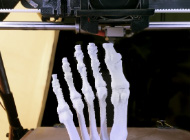 3D printing provides new opportunities for different business sectors to enable easier prototyping. It gives them the ability to create designs that are way too difficult to produce with other methods. It also allows manufacturers to build high-quality products rapidly.
3D printing provides new opportunities for different business sectors to enable easier prototyping. It gives them the ability to create designs that are way too difficult to produce with other methods. It also allows manufacturers to build high-quality products rapidly.
There are many benefits of using 3D printing in different industries. This is why most industries are now utilising 3D printing to manufacturing their products.
In line with this, here is a blog post on how industrial 3D printing is used in different industries.
Architecture and Construction Industry
When it comes to architecture and construction, 3D printing is used to produce detailed models of buildings. Before, architects only rely on CAD software to design structures. With the help of 3D printing, it is now possible to convert CAD files into 3D printable files.
In this way, architects and engineers can easily modify 3D structures and test different market potential with faster and more affordable prototyping. Some benefits of 3D printing in architecture and construction industry include reduction of material waste and invention of innovative shapes and structures.
Aerospace/Aviation
Aerospace/Aviation is one of the industries that takes 3D printing as an advantage. This is because additive manufacturing allows engineers to create customised 3d parts that are impossible to build with past methods.
With the help of additive manufacturing, engineers can quickly create, test and verify a design before investing in mass production. They can also validate if a product can funtion properly or not. It also reduces the time frame of the whole development process.
Medical/Healthcare Industry
Additive manufacturing is an useful method in the medical and healthcare industry. Nowadays, there are already some patients who have a number of 3D printed parts implanted inside their bodies. One popular example is the application of knee and shoulder joint replacements to the patients.
Aside from this, doctors can use 3D prototypes to effectively communicate with patients using tangible models. Customised 3d components can also be produced to meet many medical requirements. Using 3D printing in the medical industry is progressing rapidly today.
Entertainment
These days, filmmakers are more focused on using CGI rather than real objects. This is because using CGI is the inexpensive method to produce extraordinary images. However, they havev started to realise that mixing real objects and CGI is the best way to create a realistic movie.
When it comes to entertainment, 3D printing has changed the way how props and movie sets as well as costumes are built. Moreover, fan clubs and movie studios have utilised 3D printing to create merchandises such as action figures and other collectables.
Fashion Industry
In the fashion industry, using 3D printing enables fashion designers to create new styles and unique shapes. It also allows them to produce innovative, customised and cheaper clothes. Designers can even try an actual product to test its appearance.
Transportation/Automotive
In the transportation industry, industrial 3D printing has been very useful to provide safe and high-quality 3d parts. This additive method is used to help develop various types of vehicles.
Applications of 3D printing in different industries
3D printing is also being used in different industries to produce jigs and fixtures, end-use parts, concept models and visualisation aids. Read on below to learn more.
- Jigs and fixtures
Using 3D printing to produce jigs and fixtures allows the manufacturers to improve the production efficiency and quality of a product. Jigs and fixtures are used to hold a part in place for different uses which include assembly, machining and quality control.
- End-use parts
3D printing is utilised to produce end-use parts for field test runs and low-volume production. There are many possibilities wherein parts are well-suited for end-use applications. Some examples of these include internal components, brackets, chassis, simple mechanisms, manifolds, etc.
- Concept models
Concept models are used to show a close representation of the product. It also gives opportunity for engineers to spot early faults on the design before mass production. Using 3D printing for concept models is cost effective especially for industries such as architecture.
- Visualisation aids
3D parts can be used for visualisation aids to eliminate doubt by holding a physical object. Users are able to produce a tangible representation of a certain type of material. For instance, 3D printed internal organs of a human is used by the teacher to effectively explain the topic to the students.
Conclusion
Over the years, industrial 3D printing has developed to bring great benefits to different business sectors. These benefits include reduced material use, lowered costs, and production acceleration. It also enables designers and engineers to create anything from jigs and fixtures to visualisation aids.
Indeed, the possibilities of using 3D printing for product development and manufacturing in different industries are limitless.
If you would like to outsource 3D printing in your industry, you can seek for professional assistance by contacting a local 3D printing service provider.








